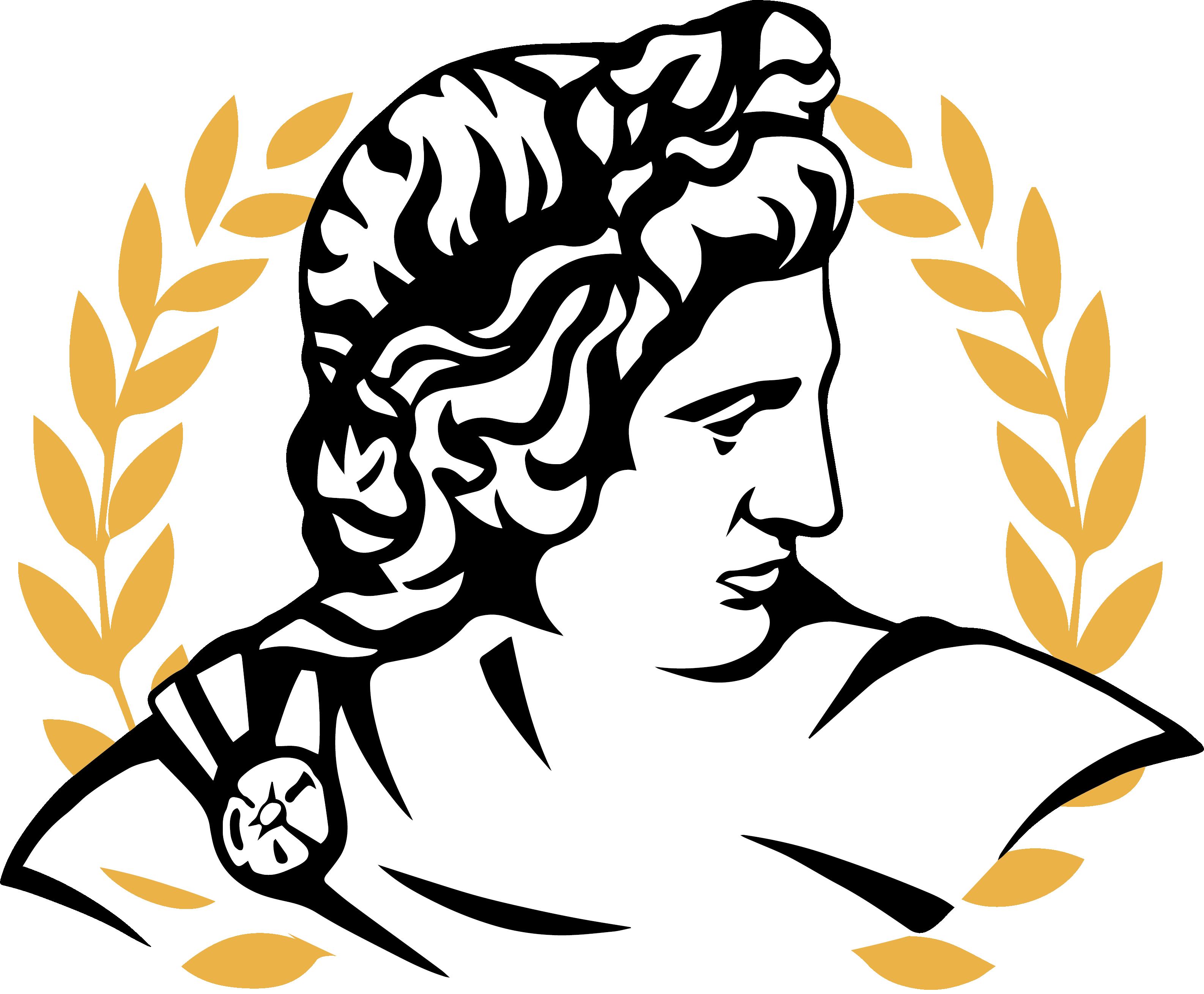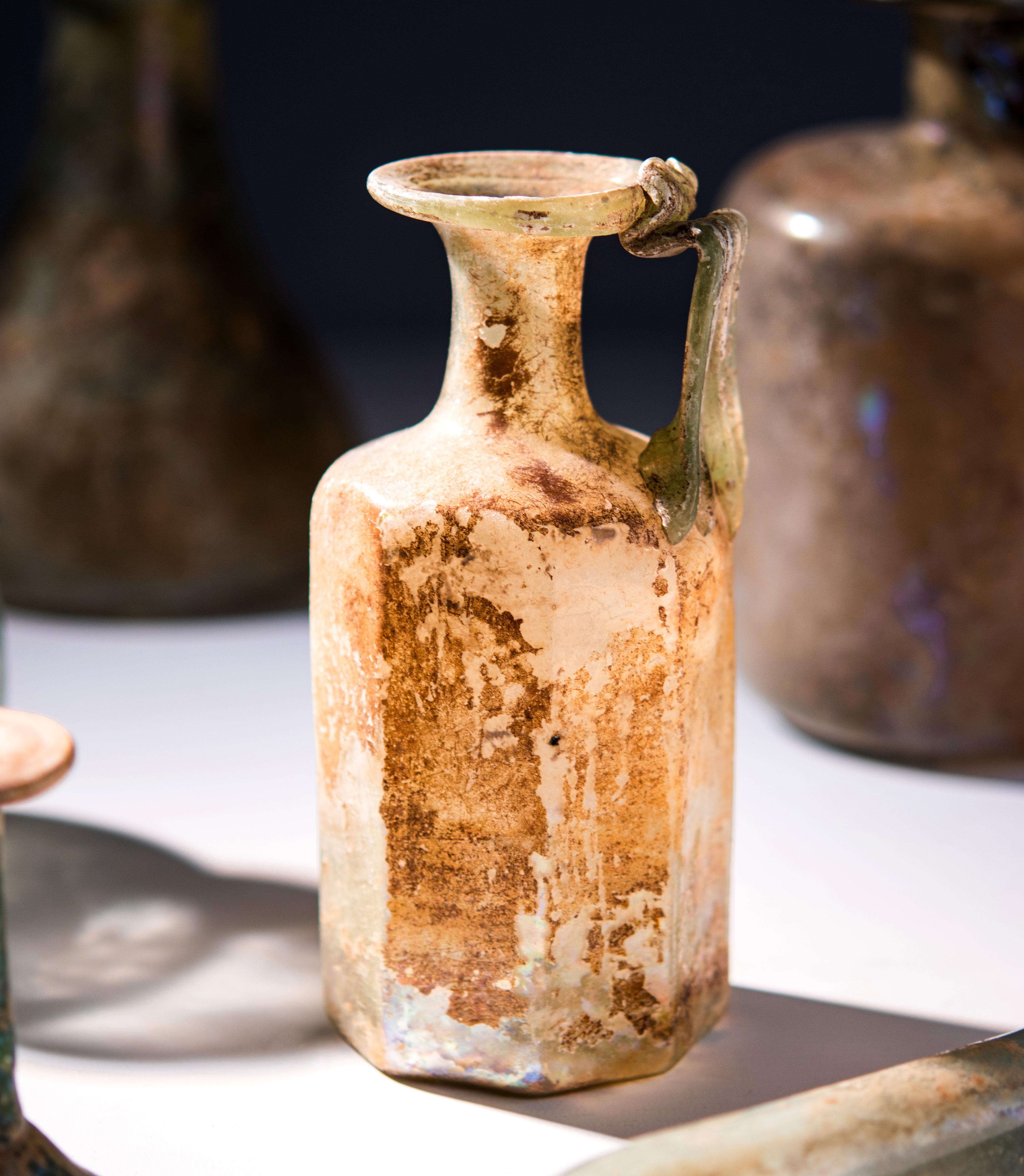Apollo Galleries








An Insight into the Artistry of Ancient Roman Glassware
Apollo Galleries presents an exquisite collection of ancient Roman glass. From small, delicate vessels to ornate vases, our curated selection showcases the diversity of Roman glassmaking techniques.
All of the items listed in this catalogue are available for direct purchase. Please feel free to signal your interest through getting in contact with our Gallery team.
We are based in the heart of Bloomsbury, adjacent to the British Museum. You can book an appointment to meet with our Gallery team or our director Dr. Ivan Bonchev, by contacting us at:
info@apollogalleries.com +44 02072422771
Apollo Galleries, 25 Bury Place, WC1A 2JH
Monday – Friday | 9:00 – 17:30
We offer a bespoke Antiquities sourcing service for our clients, working closely with our stock team to match items from across the ancient world with their perfect home.
You can contact us via the email address above to enquire about our services.
We do not charge you for advice and appraisal. Please contact us with images of your collection and we will get back to you within 2-3 business days.
We accept payments in: US DOLLARS EURO BRITISH POUND
No import taxes for most antiquities when sent to the USA. Packing and shipping is handled in-house by our professional white-glove team.



6
ROMAN LARGE CYLINDRICAL GLASS JUG
Ca. 1st-2nd Century AD
8
ROMAN OCTAGONAL PANELLED BOTTLE
Ca. 1st-2nd Century AD
8
COLLECTION OF FOUR ROMAN GLASS HANDLED VESSELS
Ca. 1st-2nd Century AD
9
ROMAN DOUBLE CHAMBERED GLASS BALSAMARIUM
Ca. 1st-2nd Century AD
9
COLLECTION OF FOUR ROMAN GLASS VESSELS
Ca. 1st-2nd Century AD
10
LARGE ROMAN HANDLED GLASS JAR
Ca. 1st-2nd Century AD
12
ROMAN GLASS OCTAGONAL PANELLED BOTTLE
Ca. 1st-2nd Century AD
14
ROMAN HANDLED JARLET AND PANELLED BOTTLE
Ca. 1st-2nd Century AD
14
ROMAN GLASS IRIDESCENT FLASK
Ca. 1st-2nd Century AD
PAIR OF ROMAN GLASS DRINKING CUPS
Ca. 1st-2nd Century AD 15
COLLECTION OF FIVE ROMANO-EGYPTIAN GLASS SPOOL VIALS
Ca. 1st-2nd Century AD
16
ROMAN GLASS FLASK
Ca. 1st-2nd Century AD
18
ROMAN AQUA GLASS AMPHORISKOS
Ca. 1st-2nd Century AD
20
COLLECTION OF FOUR ROMAN GLASS BOTTLES WITH FLARED MOUTHS
Ca. 1st-2nd Century AD
20
COLLECTION OF SIX ROMAN GLASS BOTTLES
Ca. 1st-2nd Century AD
21
PAIR OF ROMAN GLASS BOWL TYPE CUPS
Ca. 1st-2nd Century AD
21
COLLECTION OF FOUR ROMAN GLASS VESSELS
Ca. 1st-2nd Century AD 22
ROMAN BLOWN GLASS: A HISTORY OF TECHNIQUE AND DEVELOPMENT

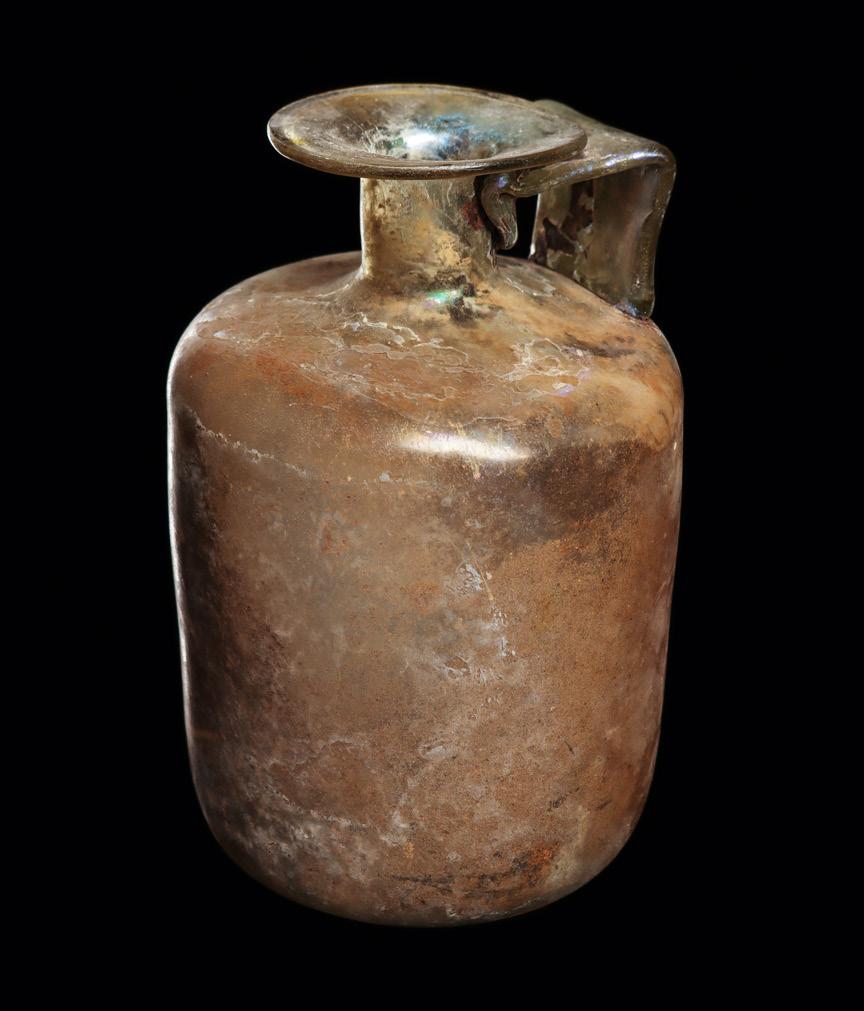
Ca. 1st-2nd Century AD
£2,000
A large Roman blown glass jug with a light yellow-green colouring. The vessel is adorned with an applied wide ribbon type handle which connects to the shoulder and the underside of the rim. The jug consists of a wide, cylindrical body with a rounded, flat shoulder. It bears a short, thin neck that expands into a wide, flat flared lip. Scattered areas of iridescent surface patina further decorate the piece. Size: 177.8mm x 101.6mm.
Provenance: Collection of Rabbi Herbert Friedman, NYC. Collected in the 1960’s in Israel. Thence, to family by descent.
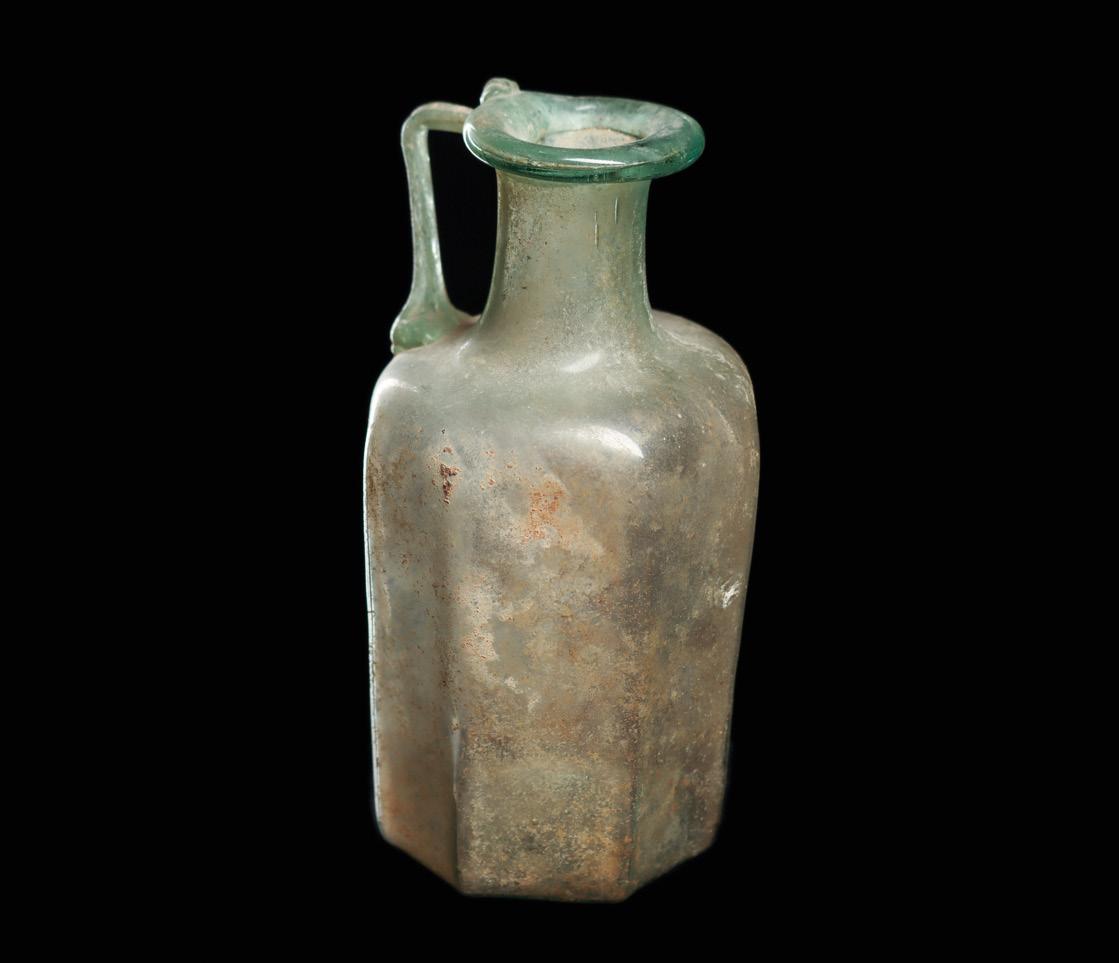
Ca. 1st-2nd Century AD
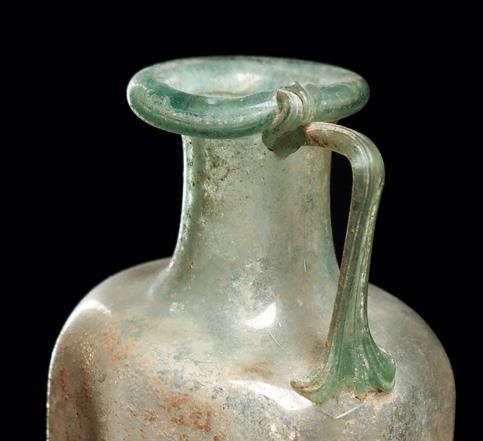
A beautiful Roman glass bottle with a blue-green colouring and an octagonal, panelled body. The vessel is slightly concave at the neck and features a flared, rolled lip. The applied handle connects to the shoulder and the top of the rim. Size: 101.6mm x 44.45mm.
Provenance: Collection of Rabbi Herbert Friedman, NYC. Collected in the 1960’s in Israel. Thence, to family by descent.

Ca. 1st-2nd Century AD
Provenance: Ex.Ye Olde Curiosity Shoppe, NJ., Dr. Arnold Saslow. Formerly, acquired in Munich in the late 1970’s. £800
A collection of four Roman blown glass vessels, all characterised by applied handles. The leftmost vessel consists of a squat, bulbous body and a long, bottle-like neck with a thick, rolled rim and one applied handle. The next is a blue-green vessel, comprised of a disc foot, expanding sides and a rounded shoulder, with a wide, flared neck. Next to it is a blue-grey vessel of a similar composition, which rests on a flat base and has a comparativeley narrower neck. The final is a squat vessel with a bulbous body and relatively wide mouth. Size: 53.98mm to 95.25mm.


Ca. 1st-2nd Century AD
A Roman double chambered balsamarium of yellow-green coloured glass. The balsamarium consists of two phials with wide columnar bodies and thick, flaring rims that curve in slightly at the middle. The balsamarium boasts elegant rigaree type handles and scattered areas of silvery iridescent patina across its surface. Size: 114.3mm x 60.3mm.
Provenance: Collection of Rabbi Herbert Friedman, NYC. Collected in the 1960’s in Israel. Thence, to family by descent.

Ca. 1st-2nd Century AD
£1,000
A group of four blown glass vessels including a tall, thin phial with a long neck that boasts a deep emerald green colour, a light yellow-green jar with a tapered bulbous body and wide flared mouth. The collection also includes a light, yellow-green cylindrical bottle with a flat, wide lip and a blue-green vessel with a flared rim and expanding, bulbous body. All of the vessels betray signs of iridescense across their surfaces. Size: 76.2mm to 123.83mm.
Provenance: Collection of Rabbi Herbert Friedman, NYC. Collected in the 1960’s in Israel. Thence, to family by descent.


Ca. 1st-2nd Century AD
Provenance: Collection of Rabbi Herbert Friedman, NYC. Collected in the 1960’s in Israel. Thence, to family by descent. £2,000
A large Roman blown glass jar that is colourless with a slight aqua tint. The jug is decorated with two opposing, applied handles that expand from the shoulder and connect to the lower rim. The jug has a wide mouth, a tooled lower rim and is decorated with nine thumb print panels. These are concentrated around the bulging body of the piece, which tapers to a flattened base. Size: 133.35mm x 95.25mm.
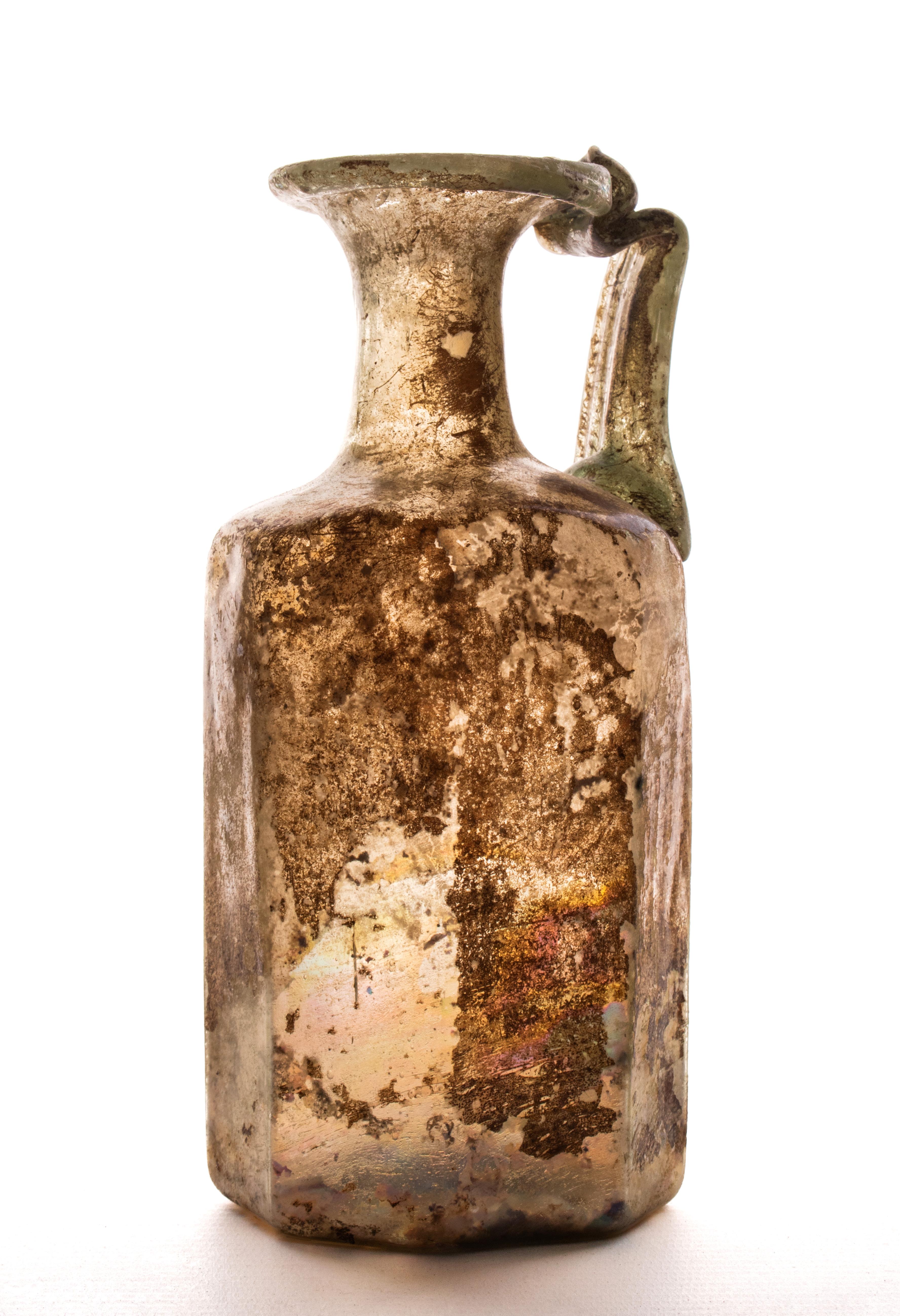
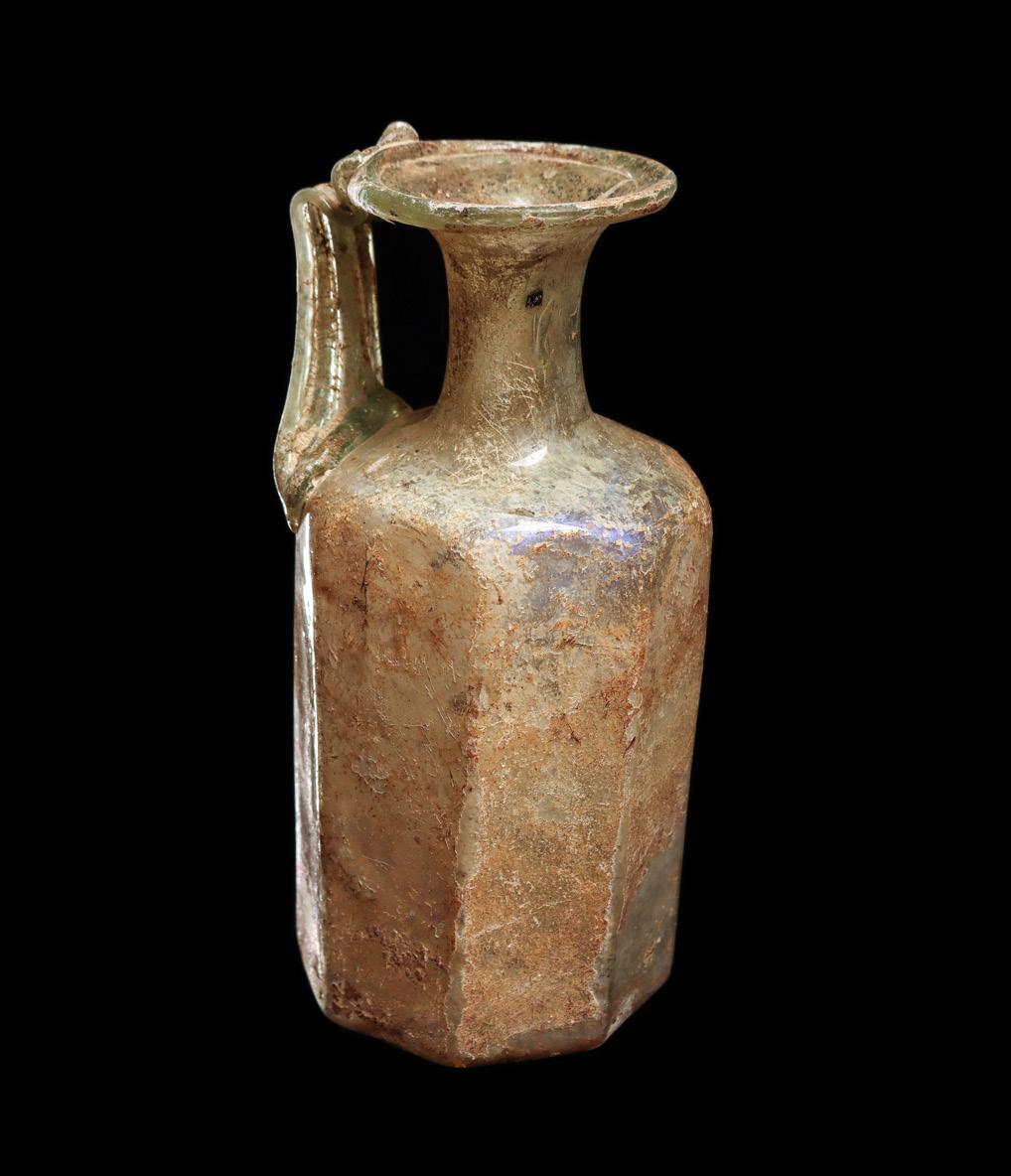
£1,500
Ca. 1st-2nd Century AD
A large Roman yellow-green glass bottle with an elegant octagonal body with an arching, applied ribbon type handle that connects to the shoulder and upper neck of the piece. The base of the bottle features a diamond shaped element, and the vessel expands into tall, flat sides with a rounded shoulder and thin, concave neck. This expands into the large, rolled flat rim. The surface of the bottle bears some surface encrustation and a beautiful iridescent patina. Size: 165.1mm x 69.85mm.
Provenance: Collection of Rabbi Herbert Friedman, NYC. Collected in the 1960’s in Israel. Thence, to family by descent.
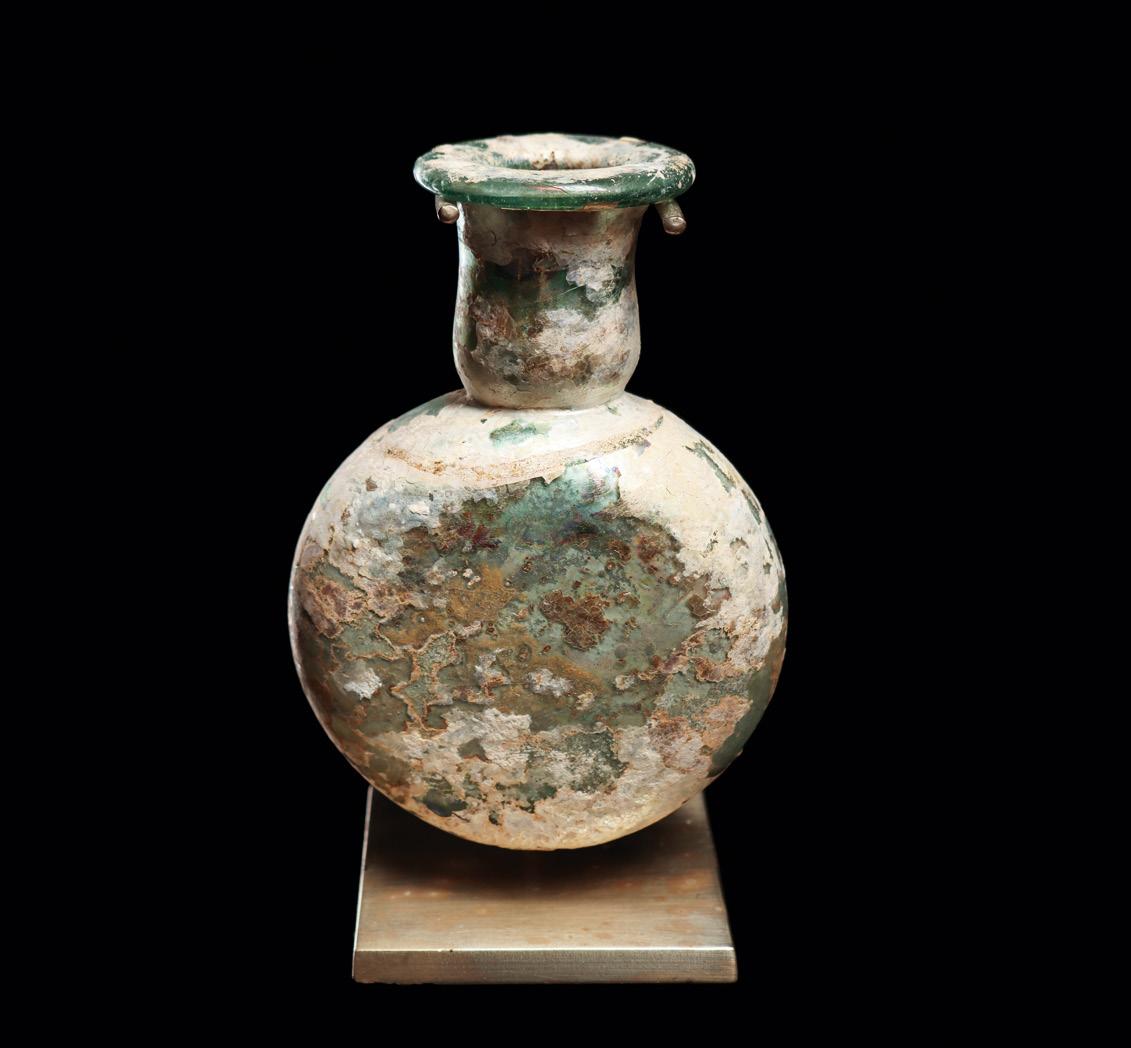
Ca. 1st-2nd Century AD
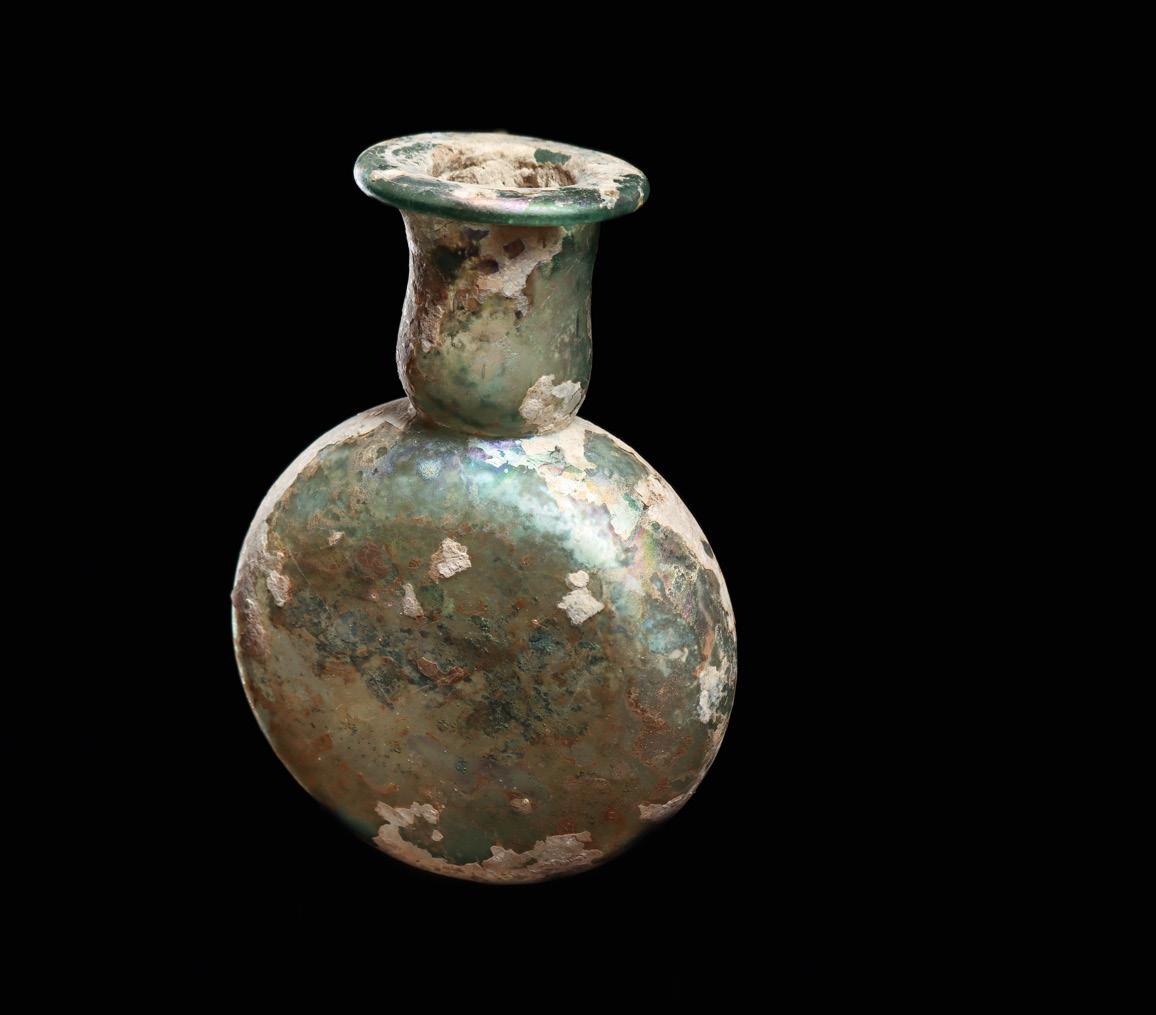
A Roman blown glass flask with a beautiful blue-green colouring. The flask has a flat, disc-shaped body and a wide, short neck that has been tooled in at the base. The flask culminates in a flat, rolled rim lip. There is striking iridescence scattered across the surface of the vessel. Size: 117.48mm x 76.2mm.
Provenance: Collection of Rabbi Herbert Friedman, NYC. Collected in the 1960’s in Israel. Thence, to family by descent.

£600
Ca. 1st-2nd Century AD
A set of two contrasting pieces of Roman blown glass. The first is an aubergine coloured cylindrical bottle with four paeled sides, a rounded shoulder, and rolled lip. It is unusual in that the panels have been hand-impressed. The other vessel is a small blue-green glass jug with an applied ribbon type handle and vertical ribbed cylindrical body. Size: 95.25mm to 114.3mm.
Provenance: Collection of Rabbi Herbert Friedman, NYC. Collected in the 1960’s in Israel. Thence, to family by descent.
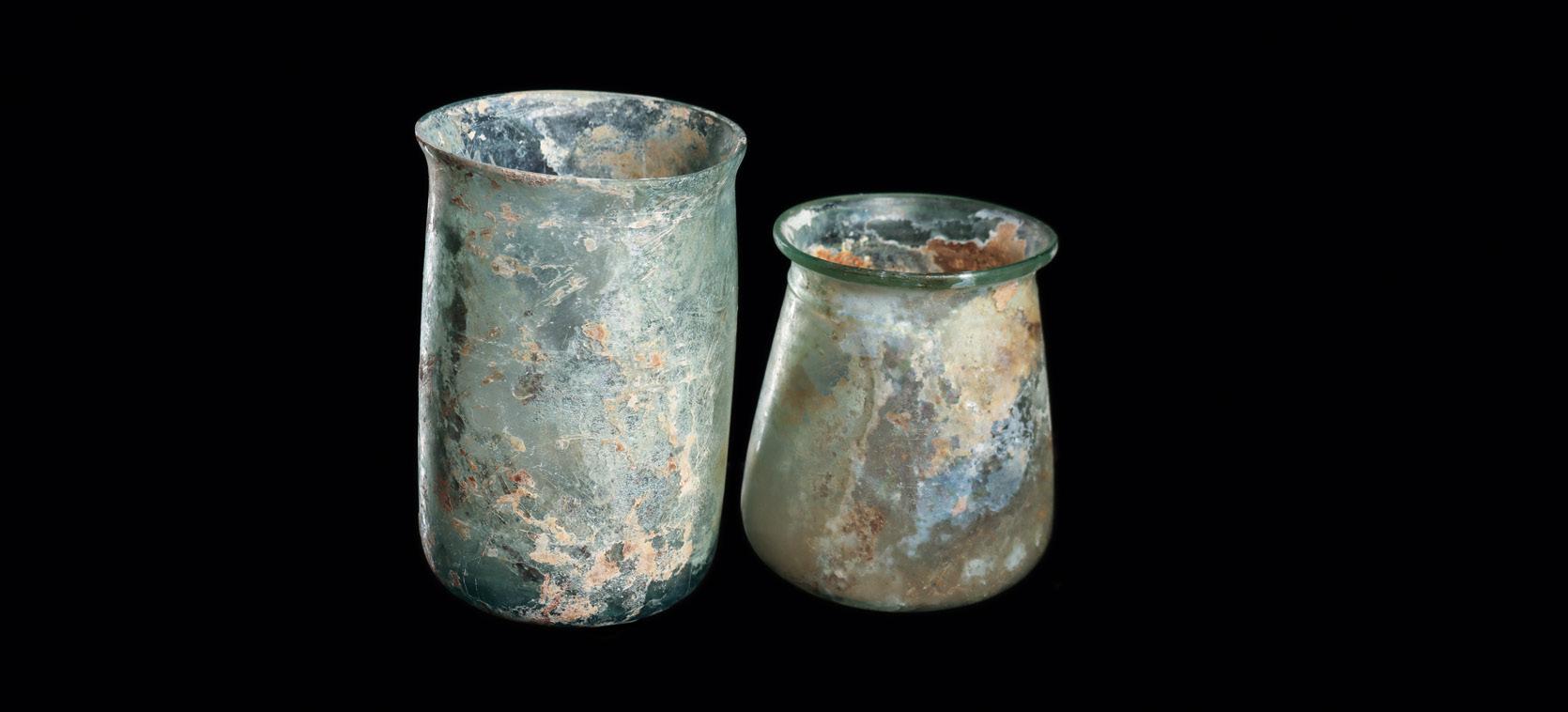
Ca. 1st-2nd Century AD
A set of two different blown blue-green glass drinking vessels with flat bottoms. The first is a cylindrical cup with two delicately incised bands that wrap around the body, terminating with a thin, slightly flared lip. The set also includes a cup with a tapering body and slightly flared rim. Size: 70.95mm x 63.5mm; 82.55mm x 69.85mm.
Provenance: Collection of Rabbi Herbert Friedman, NYC. Collected in the 1960’s in Israel. Thence, to family by descent.
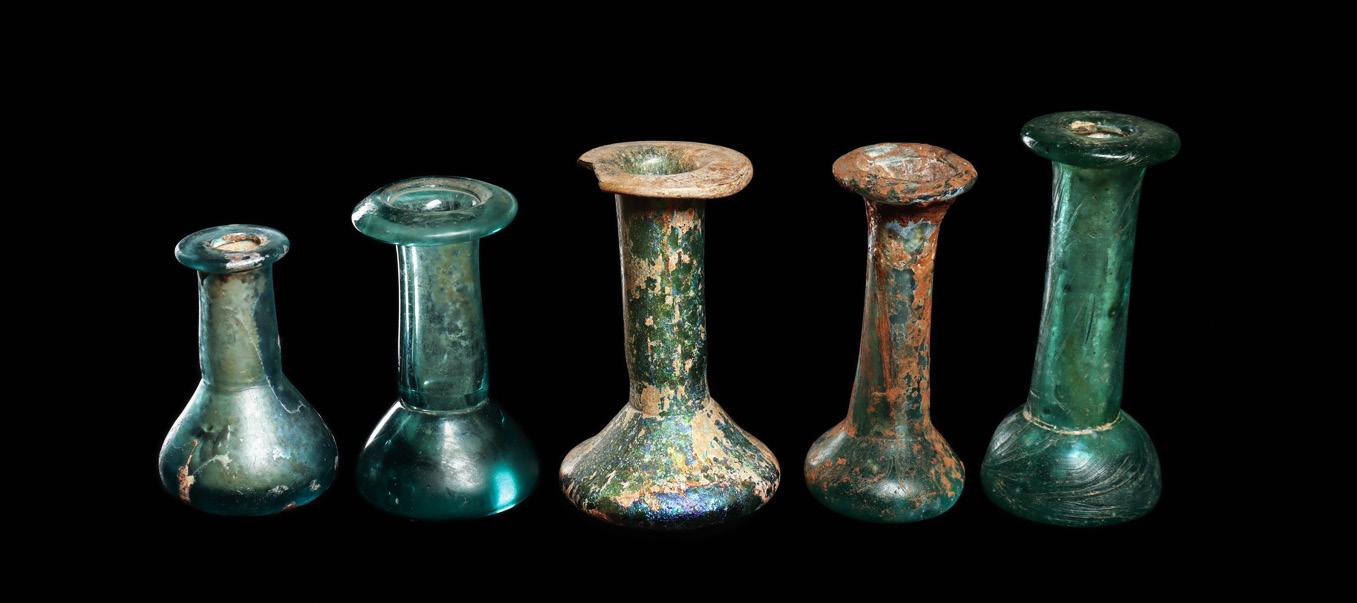
Ca. 1st-2nd Century AD
£800
A collection of five Romano-Egyptian blown spool phials in various pleasing shades of blue-green. All of the vessels are unique but follow a similar pattern, being characterised by flat bases and conical bodies which taper into tall, cylindrical necks of various thicknesses. The mouths and rims of each vessel vary in size, featuring either tightly rolled openings or large, flared mouths. Size: 66.68mm to 101.6mm.
Provenance: Ex.Ye Olde Curiosity Shoppe, NJ., Dr. Arnold Saslow. Formerly, acquired in Munich in the late 1970’s.

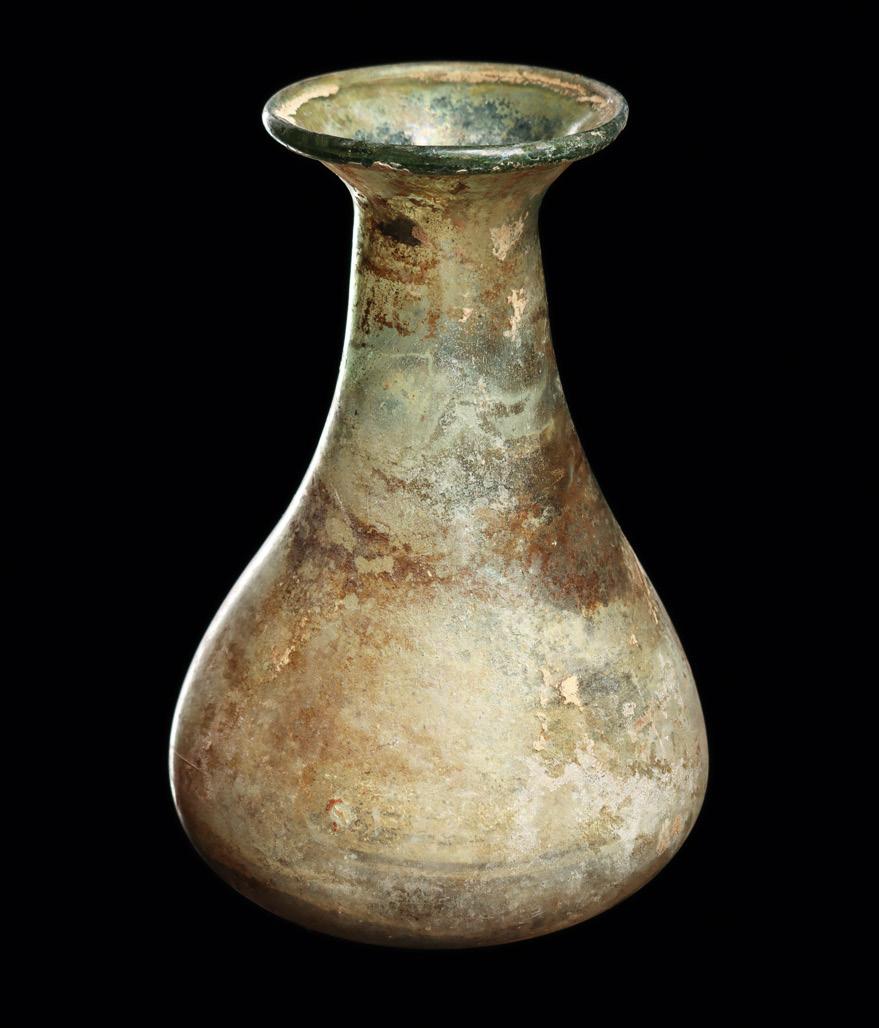
Ca. 1st-2nd Century AD
Provenance: Collection of Rabbi Herbert Friedman, NYC. Collected in the 1960’s in Israel. Thence, to family by descent. £1,500
A Roman glass flask of a blue-green colouring consisting of a wide, conical body that tapers to a thin neck, wide, flaring mouth and rim. Scattered areas of encrustations and iridescence adorn the surface of the piece. Size: 177.8mm x 127mm.


Ca. 1st-2nd Century AD
£1,500
A Roman blown glass amphoriskos with an aqua colouring. The amphorikos has a long tapered body with a light vertical ribbed pattern adorning the surface. The upper portion of the piece features opposing applied handles, a funnel mouth, and a rolled rim. Slight encrustation and iridescence adorns the surface. Size: 184.15mm x 60.33mm.
Provenance: Collection of Rabbi Herbert Friedman, NYC. Collected in the 1960’s in Israel. Thence, to family by descent.

Ca. 1st-2nd Century AD
A collection of six Roman blown glass bottles of various colours. All of the vessels have bulbous or tapered bulbous bodies, cylindrical necks, and thick, rolled rims. Five have strong iridescent surface patinas. Size: 76.2mm to 111.13mm.
Provenance: Ex.Ye Olde Curiosity Shoppe, NJ., Dr. Arnold Saslow. Formerly, acquired in Munich in the late 1970’s.

Ca. 1st-2nd Century AD
A collection of four different blown glass bottles, all characterised by flaring mouths. The collection features a light yellow-green coloured example with a tapered, bulbous body and light, dimpled decoration around the body, and a light blue-green bottle with a wide neck and mouth, with a large area of auburgine color deposit on the interior. The remaining two yellow-green glass bottles have their long, flaring necks reattached at the shoulder, which expand into squat, bulbous bodies. Size: 95.25mm to 139.7mm.
Provenance: Ex.Ye Olde Curiosity Shoppe, NJ., Dr. Arnold Saslow. Formerly, acquired in Munich in the late 1970’s.

Ca. 1st-2nd Century AD
A set of two Roman blown glass cups, both with slightly flared, wide rims. The right is a blue-green example with a vibrant colouring and silvery iridescence, characterised by a flat bottom, rounded base, and slightly tapering body. The left and slightly smaller yellow-green example has a flat rim, a rounded, bulbous body and is remarkably transparent. Size: 69.85mm x 85.73mm; 50.8mm x 69.85mm.
Provenance: From the estate of Peter H. Tillou, CT., acquired in the 1990’s. Thence, to family by descent.
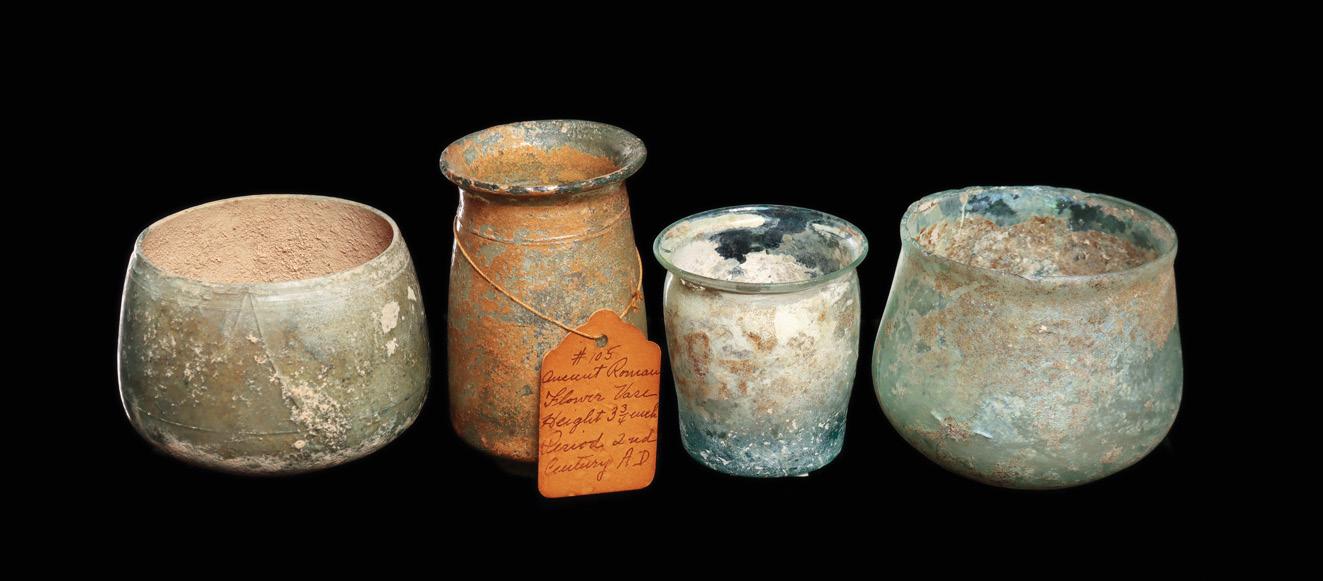
Ca. 1st-2nd Century AD
£600
A collection of four wide-mouthed Roman blown glass vessels. The collection includes a tall blue-green, cylindrical vessel with a slightly tapered body, a flared rim, a simple applied glass thread around the neck, and a drawn disc foot. It features an early collection tag marked: “R.H. Macy & Co Inc 12.(18)89. with penned description on the tag & #105, and an additional label affixed on the base: “105”. The other vessels consist of small blue-green drinking vessels, one with a rounded body and flared rim, and two with tapering sides. The larger of the two bears a slightly flared, thin rim. Size: 66.68mm to 92.25mm.
Provenance: From the estate of Peter H. Tillou, CT., acquired in the 1990’s. Thence, to family by descent.
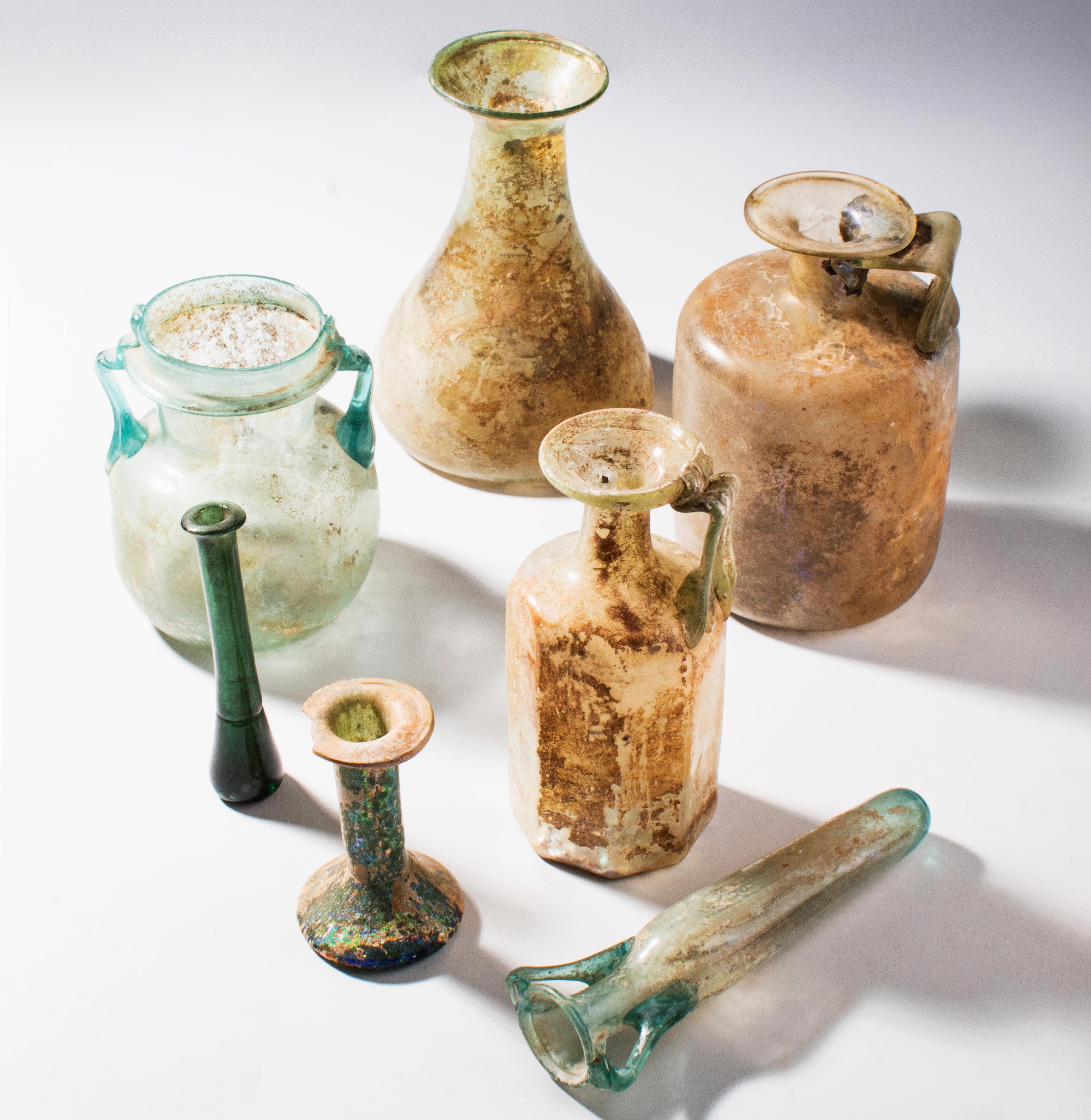
Roman glassware of the Late Republic and Early Imperial period was strongly influenced in its types and styles by luxurious metal tableware made in precious metals such as silver. Like much of the artistic output of the time, the designs of the best examples of Roman glassware imitate the lathe-cut and punched tableware of the Hellenistic world, which was gradually conquered by the Roman war machine during the 2nd Century BC.
This older, more reactionary style of glassware was, however, eclipsed in the 1st Century AD by a new class of material, as the industry was revolutionised by the increased commercialisation of the technique of glassblowing. This technique transformed the ancient glass industry and put the Roman Empire at its forefront in terms of artistic innovation and scale of production.
The earliest evidence for glassblowing has been found on the Syro-Palestinian coast in the early 1st Century AD, with Pliny the Elder marking out the ancient city of Sidon as a key centre for the practice. [1] The favourable economic conditions created by Augustus, who had brought peace to Italy and its provinces following the civil wars of the 1st Century BC, encouraged many of these artisans to reclocate to Italy, where both foreign and local workshops began to flourish in Rome and elsewhere across the country. [2]
Why was this new technique so popular? Glassblowing had many practical advantages over previous methods of production such as sand-core and cast glass, although glassware made using these techniques continued to be produced long into the Imperial period. Glassblowing used less raw material, was less labour intensive, and allowed artisans to create a plethora of designs that varied in terms of shape and decoration, utilising glass trailing for example to create added complexity to each vessel. It even allowed glassblowers to recycle their unused fragments by simply melting them down again. A fact that was discovered in the Flavian period (AD 69-96) and lauded by contemporary poets such as Martial, Juvenal and Statius. [3]
From the 1st to 2nd Centuries AD, the Romans became glassblowers par excellence, producing stylistically distinct vessels in vast quantities and to a very high standard. This burgeoning native industry captured the attention of Petronius, who relates this perhaps apochryphal anecdote regarding the skill of Roman artisans:
There was a craftsman that once made a glass bowl that didn’t break. So, he got an audience with the emperor, taking his present with him. Then he made Caesar hand it back to him and dropped it on the floor. The emperor couldn’t have been more shaken. The man picked the bowl of the ground – it had been dented like a bronze dish – took a hammer from his pocket and easily got the bowl good as new. (Petronius. Satyricon. 51)

It is unlikely that the Romans truly did invent unbreakable glass, but scholars have surmised that the story of such hammered vessels relates to mould-blown glass, which was intricately decorated in relief and knownfor its durability. [4]
The Romans were master innovators, improving on tools such as the clay-blowing pipe through the invention of its iron counterpart which facilitated the production of larger glass vessels. [5] They also produced various coloured glass vessels through the addition of metal oxides, adding iron to create a lovely emerald colour or cadmium to create the vibrant yellow hues. However, the last years of the 1st Century AD marked a change in stylistic preferences, with these strong colours overtaken by “aqua” and colourless vessels, which dominated the market for centuries, possibly for their resemblance to rock crystal. [6]
In any case, glass blown vessels became ubiquitous across the empire, with eminent workshops in Spain, Italy, Gaul, and the Syro-Palestinian coast. [7] These vessels varied in function, with glass balsamaria for example being ideal for the storage of perfumes, oils and cosmetics due to their odourless and non-porous nature. The ease and low start-up cost of the glassblowing process also made the vessels relatively accessible, and they came to be used by nearly all stratas of Imperial society. [8]
The 3rd to 4th Century AD saw a shift in the glassblowing industry. Emperor Diocletian’s price edict of AD 301 set maximum prices for various blown vessels that were thought by some to be too low, driving artisans out of the Roman market. In addition, Constantine granted a tax exemption for all glassworkers who moved to his new capital Constantinople, attracting many artisans and rejuvenating the eastern glass industry. [9] Despite these changes, Roman glass production continued and became increasingly elaborate. The pinnacle of this craft is exemplified by the “Lycurgus Cup”, a magnificent cage cup adorned with an elaborate myth featuring Dionysus. The cup is remarkable as it changes colour from green to red in different light qualities.
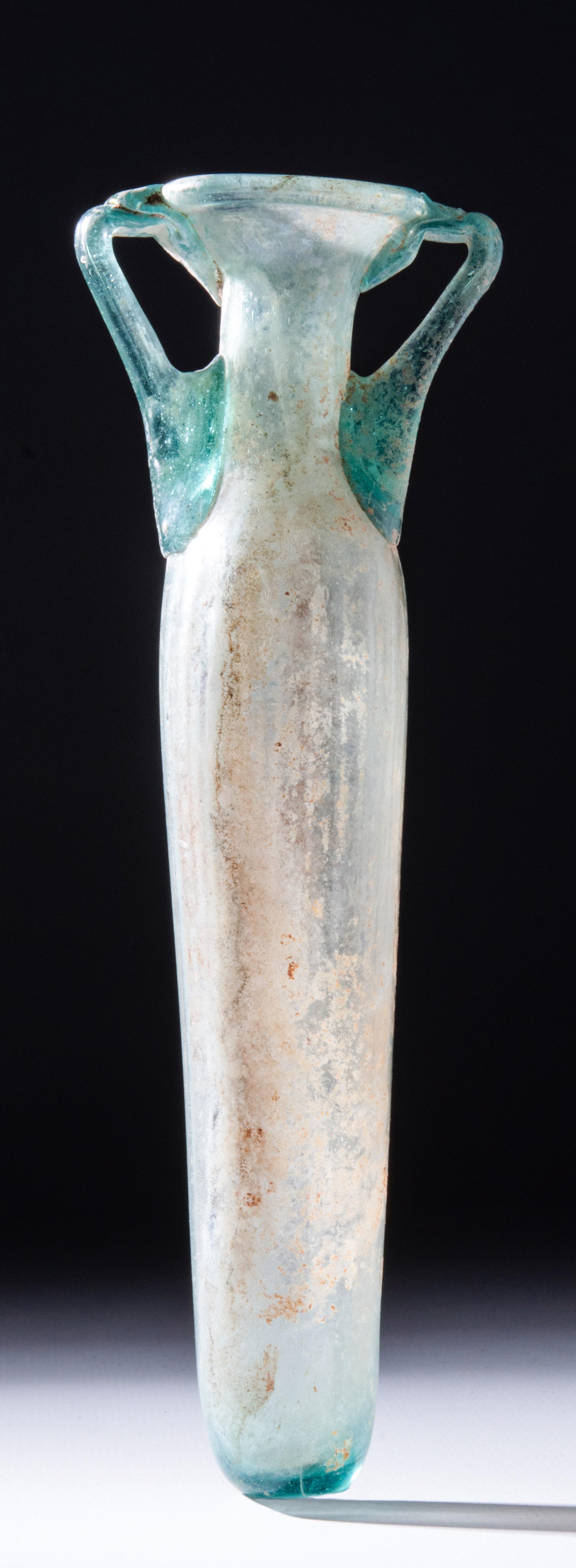
Allen, D., 1998, Roman Glass in Britain. Princes Risborough. Fleming, S. J., 1999. Roman Glass; reflections on cultural change. Philadelphia.
Israeli, Y., 1991, “The Invention of Blowing” in Newby, M. and Painter, K. (eds.), Roman Glass: Two Centuries of Art and Invention, London, 46-53.
Stern, E. M., 1999, “Roman Glassblowing in a Cultural Context.” American Journal of Archaeology, 103(3), 441–484.
Notes
[1] HN 36.193; Israeli 1991, 46-53.
[2] Stern 1999, 443.
[3] Martial. Epigr. 1.41.3-5, 10.3.3-4; Statius. Silv. 1.6.73-4; Juvenal 5.47-8.
[4] Stern 1999, 444.
[5] Stern 1999, 446.
[6] Plin. HN. 36.198; Allen 1998.
[7] Plin. HN. 36.190.
[8] Strabo. Geog. 16.2.
[9] Fleming 1999.
We pride ourselves on providing excellent customer care to all of our clients. If you have any inquiries regarding the items, our team will be happy to guide you through every step of the way. We strive to ensure that every customer has a smooth and enjoyable experience. In addition, we value feedback from our customers and are always looking for ways to improve our services. If you have any suggestions or comments, please do not hesitate to let us know.
At our gallery, we take privacy and safety very seriously. We understand the importance of protecting our clients’ personal and financial information, as well as ensuring that all transactions are secure and confidential. We have implemented industry-leading security measures to safeguard your data and prevent unauthorised access. Our website is encrypted with advanced SSL technology, which ensures that all sensitive information is transmitted securely over the internet. In addition, we adhere to strict privacy policies and will never share your information with any third parties without your consent. We also require all of our employees to adhere to strict confidentiality agreements to protect your information. When it comes to the physical safety of our clients, we maintain a secure and controlled environment at our gallery. Our premises are equipped with surveillance cameras to ensure the safety of our clients and their property.
We understand that privacy and safety are of utmost importance to our clients, and we are committed to providing a secure and trustworthy experience. If you have any questions or concerns about our privacy and safety policies, please do not hesitate to contact us.
We want you to be completely satisfied with your purchase, and we understand that there may be circumstances where you need to return an item.
Returns:
If you receive an item that is not as described, you may return it to us for a refund. However, please note that we only accept returns if there is substantial proof provided by a certified expert that the item is not as described. To initiate a return, please follow these steps:
- Contact us within 7 days of receiving the item to notify us that you would like to return it.
- Provide us with substantial proof from a certified expert that the item is not as described.
- Pack the item securely in its original packaging, if possible, and ship it back to us.
- Once we receive the item and verify that it is not as described, we will issue a refund to you. Please note that shipping and handling fees are non-refundable.
Refunds:
We will issue a refund for the full purchase price of the item, including any applicable taxes, once we have received the item and verified that it is not as described.
Please note that it may take several days for your refund to appear on your credit card statement, depending on your bank’s processing time.
If you have any questions about our return and refund policy, please do not hesitate to contact us. Thank you for choosing our gallery for your purchase.
Thank you for shopping with the gallery. We aim to provide you with a seamless and convenient shopping experience. Please read the following shipping information to ensure that your order is delivered to you promptly and safely.
Processing Time:
Once you have placed your order, we will process it within 1-2 business days. During high-demand periods, processing may take longer.
Shipping Options:
We offer several shipping options for your convenience. You can select your preferred shipping method during checkout. The shipping options available may vary depending on your location.
Shipping Rates:
The shipping rates for your order will depend on the shipping method you select and the destination of your package. Shipping rates will be calculated and displayed at checkout.
Delivery Time:
The delivery time for your order will depend on the shipping method you select and the destination of your package. We aim to deliver all orders within the estimated delivery time provided, but please note that delivery times may vary due to factors beyond our control.
International Shipping:
We offer international shipping to select countries. Please note that additional customs fees, taxes, and duties may be applied by your country’s customs agency. These fees are the responsibility of the customer and are not included in the shipping charges.
Tracking Your Order:
Once your order has been shipped, we will provide you with a tracking number via email. You can use this tracking number to track your package online.
If you have any questions about our shipping information, please do not hesitate to contact us. Thank you for choosing our gallery for your purchase.
- Credit / Debit Cards - PayPal - Offline Payments
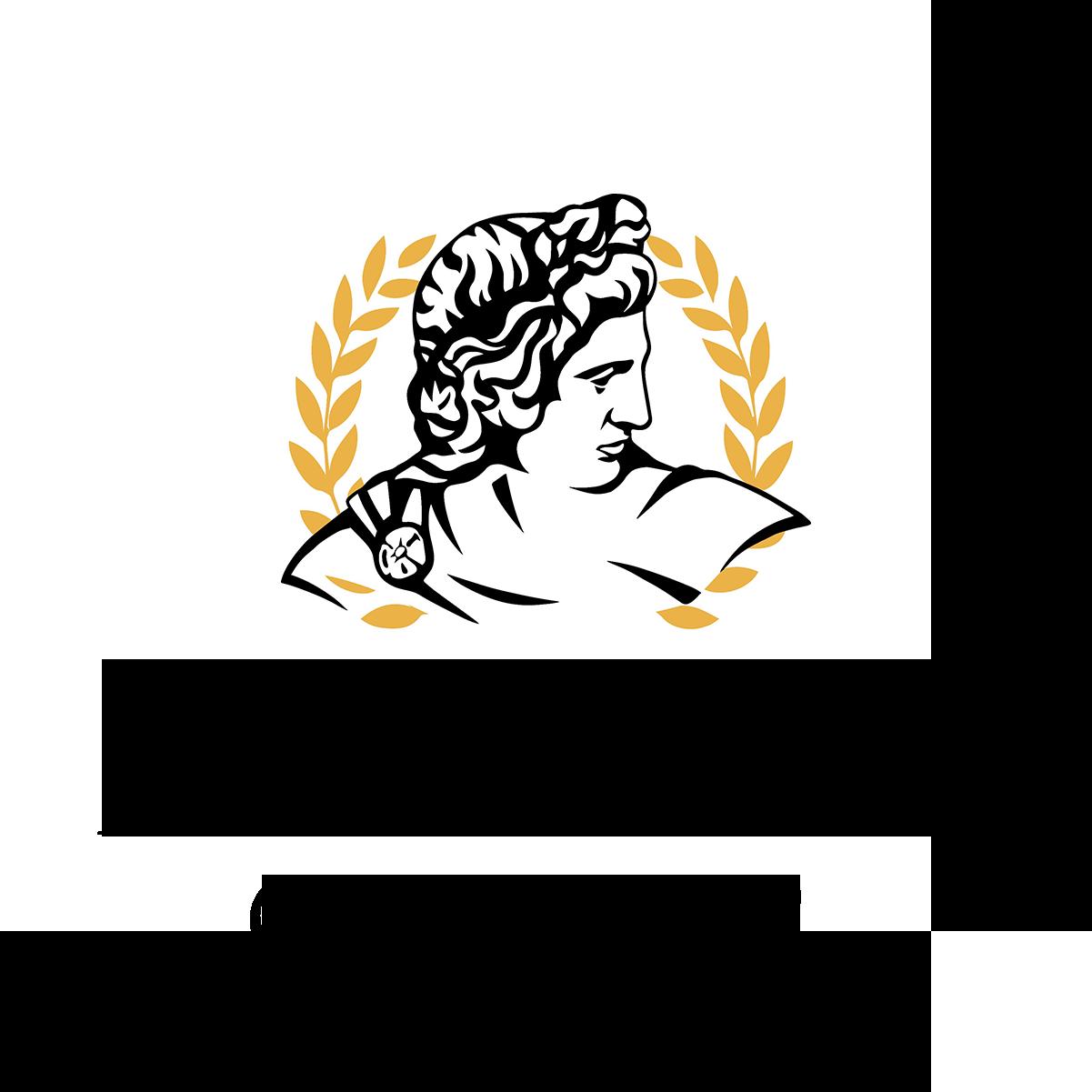
Collection Curated by Dr. Ivan Bonchev
Margherita Gorini
Gallery Administration
Margherita Gorini
Ella Wakefield
Catalogue Design
Margherita Gorini
Ella Wakefield
Photography
Kiah Tao
Raphael Werneck
Roman Blown Glass
A Short History of Technique and Development
Ella Wakefield
